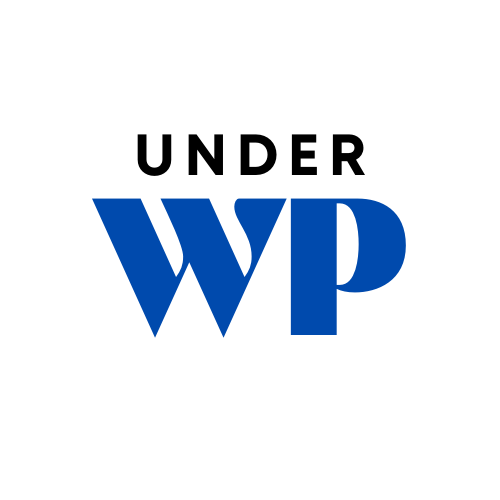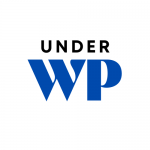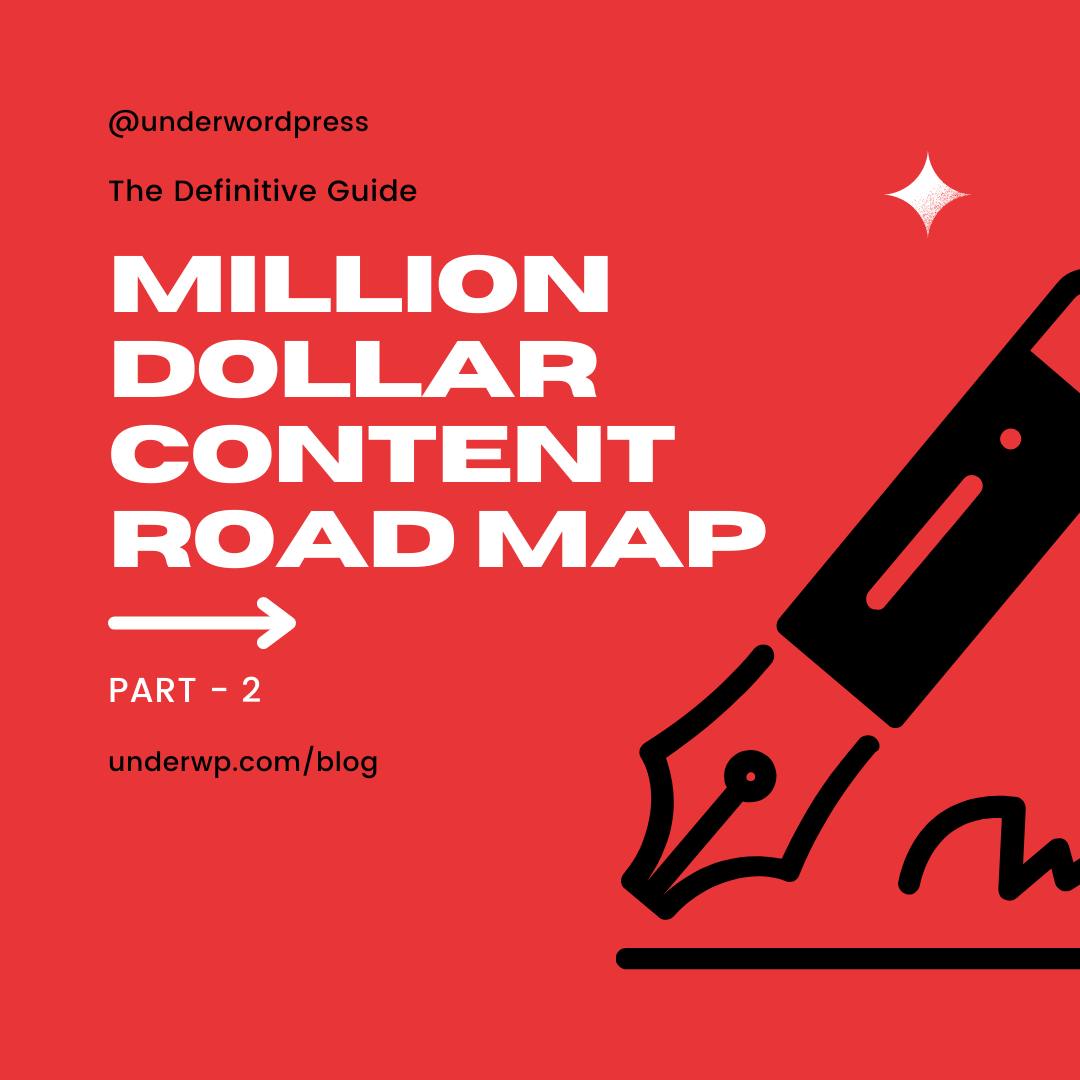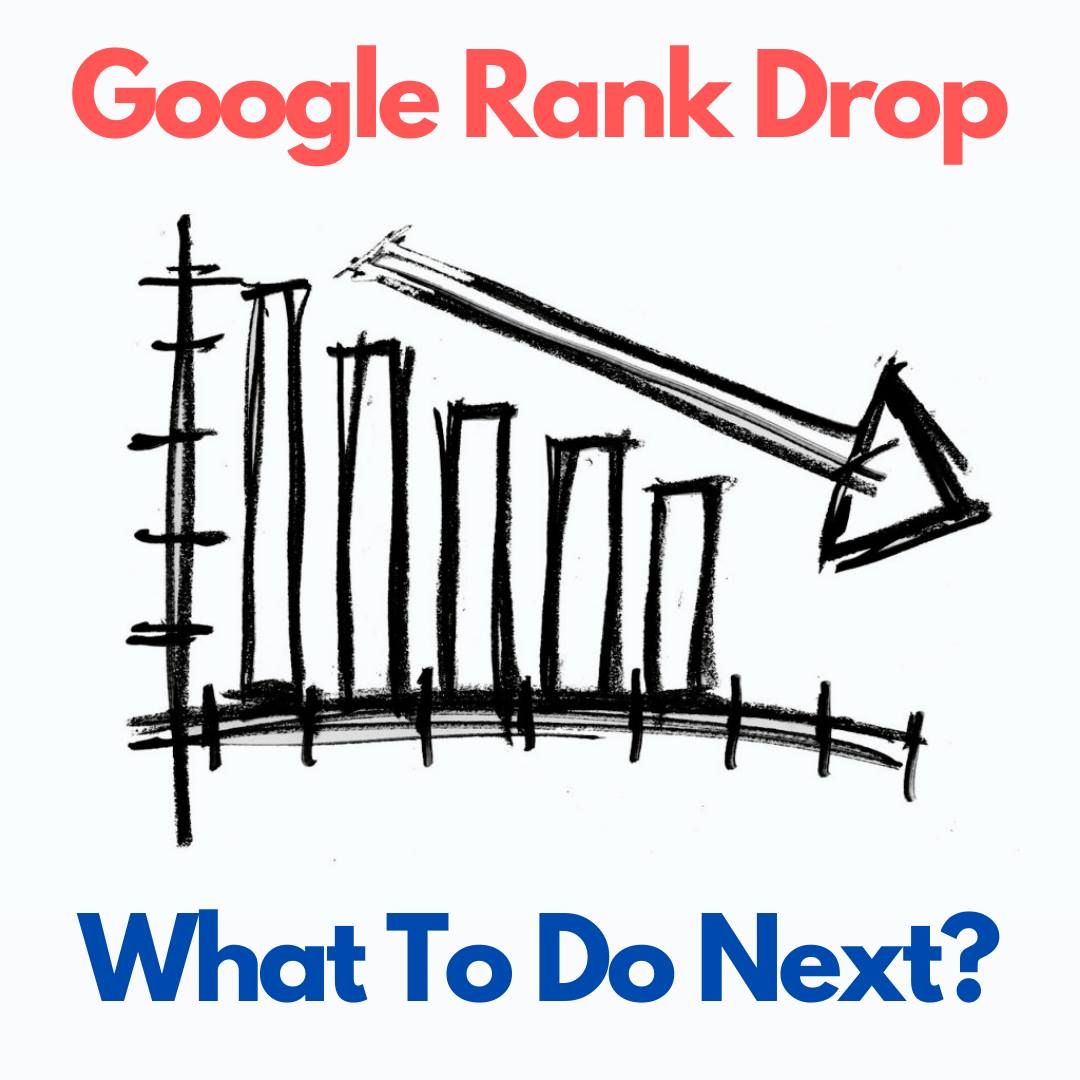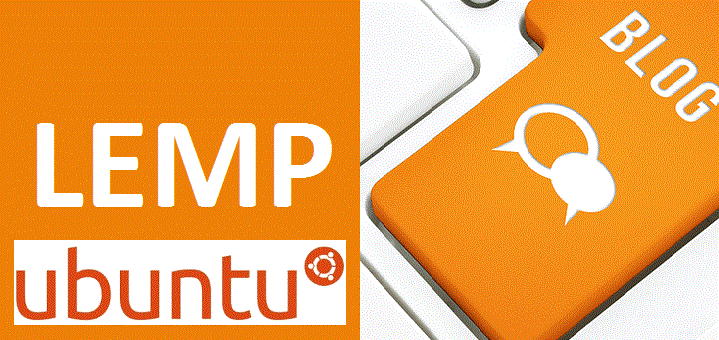Content is the backbone of search engine optimization (SEO). Without quality content, SEO is useless.
Content Strategy is the use of your content to achieve a business objectives. It uses the content that's already been created as well as planning for its creation in the future.
A good strategy will also look to improve your online presence, which is exactly what you need for SEO purposes.
This guide which is a series of posts in three parts, explores why content matters on SEO, how to determine your website's need for content, and how to develop a content strategy for your site or client's sites.
To read its first part, go here: Million Dollar Content Road Map: The Definitive Guide – Part 1
Content Structure
Now I wanna go into the content structure and again it depends on how long people have been in the industry.
None of this is probably going to be revolutionary but it's the kind of thing that we see missed over and over again. And the kind of stuff that is often not rolled down and articulated to content teams.
Our goal is to create a structure around this that can be easily disseminated and passed down to content teams so you don't have to continue to repeat the wheel or invent the wheel rather.
Headlines
The first thing i like to focus on is headlines.
Only because sometimes this is the last thing that writers focus on and it can be a mistake. And there are a lot of reasons why.
There's a stat that says “80% of readers never make it past the headline” and I've been guilty of this myself.
I've created a piece of content and spent you know hours writing it and then when it comes down to the headline I just spend maybe five minutes thinking something and then put it out there.
Sometimes I will actually push writers to spend as much time on the headline as they do in the content piece which in essence sounds crazy but really it is important.
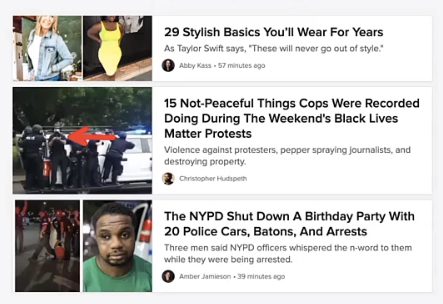
What you're seeing in the above image here is a set of examples from BuzzFeed
Now, BuzzFeed is kind of notorious for clickbait but you can start to discern a pattern with their titles and this is the kind of thing that is replicated not only with BuzzFeed but other websites only because it works.
It's a proven methodology.
One of the things you'll notice with all of these titles they all have numbers in them.
You have 29 stylish basics you'll wear for years.
The next title is long and almost hard to read but “15, not peaceful things cops were recorded doing during the weekend's black life matters protest”
These are the kind of things that stick out and there's a certain formula that we'll kind of dissect here that we can emulate and use to our advantage.
One of the exercises I did as part of writing this posts series is examining the search results. This is another thing that in the research processes we realized was missed a lot of times.
We'll go to our keyword research tools, we'll get some ideas and then we'll start writing but we never stop to examine what's already in the search results and how that might impact how we craft not only our title but our content in general.
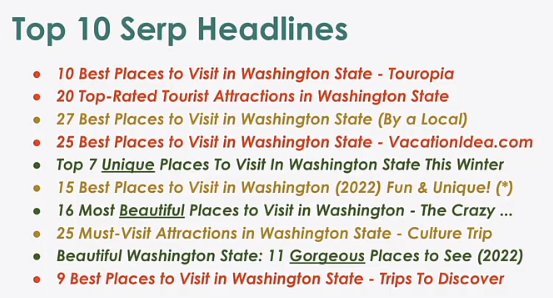
I did a google search for places to visit in Washington state and these are the titles at the top.
So there's this idea of the skyscraper method and typically this deals with the content piece itself.
You want to go bigger and better, you want to make sure that your piece of content has maybe more word count than those you're competing with, or you know more multimedia or additional aspects, etc.
But a lot of times we want to do the same thing with headlines. We want to figure out how can we make a bigger and better headline and how can we also make it stand out.
Let's take a look at the first few that are marked in red.
We have “10 best places to visit in Washington state”, “20 top-rated tourist attractions in Washington state”, and “25 best places to visit in Washington state”.
Now, to me, I see these three articles and outside of just the pure count which at some point becomes daunting.
If I see this in the search results, the chance that I'm going to do one of these three is fairly probably even.
Let's take a look at some of those in green.
The reason that I highlighted these in green or yellow is that there are characteristics that make them stand out amongst the fold.
In so middle section, we have “Top 7 unique places to visit in Washington state this winter”. It's calling out a characteristic that hopefully would stand out amongst the pack and encourage conversions and clicks.
You have the word “Unique” and then you have the emphasis on Winter.
This may not perform as well in the summer but if you're interested in winter sports, you can guarantee that this is probably the result you're going to click into versus the others.
The next one is marked in dark green “16 most beautiful places to visit in Washington”
Again, this is a unique characteristic. It stands out topically from the rest of the content if I'm interested in beautiful scenery or beautiful places to visit.
I can get a good sense already of what the article is about and there's a good chance that once I click on through I'm going to probably digest more of that piece of content than I might with some of these more general or specific topics.
We're going to be using this keyword and putting this into a tool like Answer The Public because again this can be a great tool and resource for creating titles.
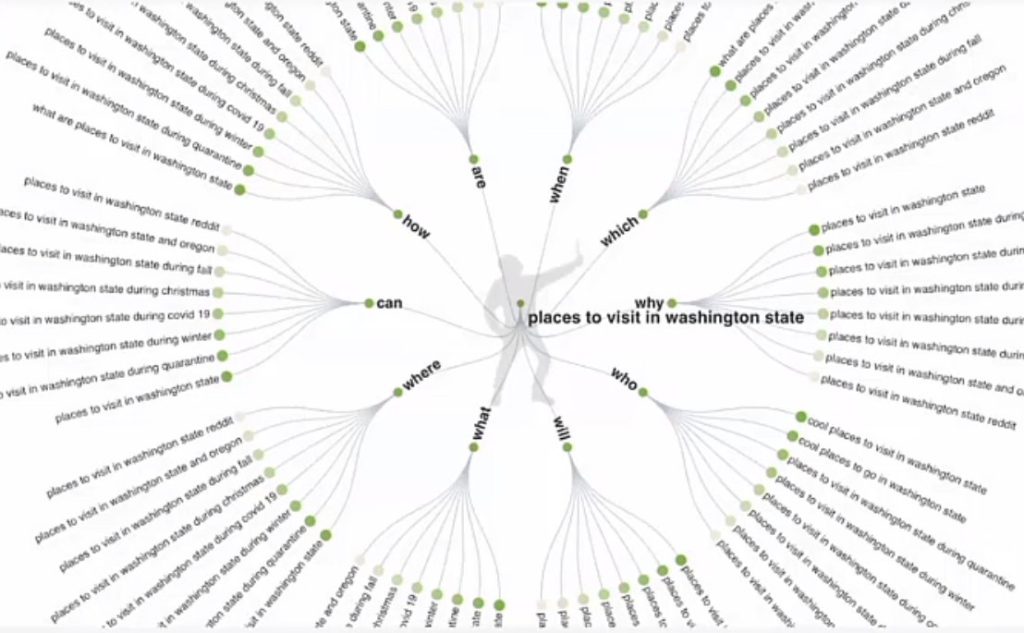
So we're going to put “places to visit in Washington state” and to Answer The Public here we're giving a lot of queries which can be doubled up as titles.
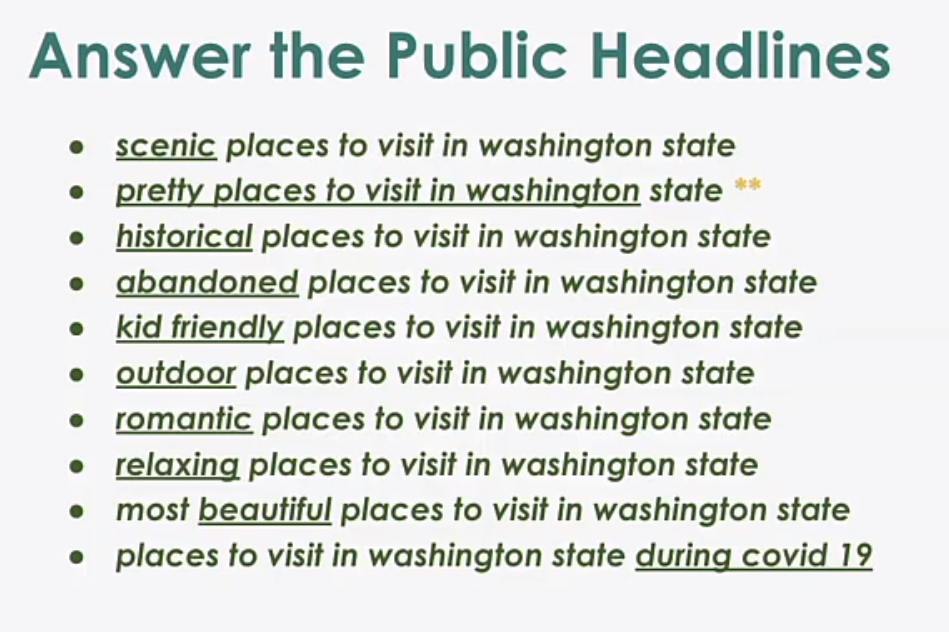
These are um some of the questions, the queries, that came out of that result that also would make, in my opinion, fantastic headlines.
So you have “scenic places to visit in Washington state”, “pretty places to visit in Washington state”, “historical places to visit in Washington state”, “kid-friendly”, “romantic”, “relaxing”, etc.
You have these things that typically have a focus. And allow us to hone in on a particular audience.
In our experience that can be really beneficial for a content piece.
We want to start to niche down ensuring there's a broad enough audience but niching down to interest and focus.
Headline Structure
Now, let's talk about headline structure.
This is another one of those things that can be templatized.
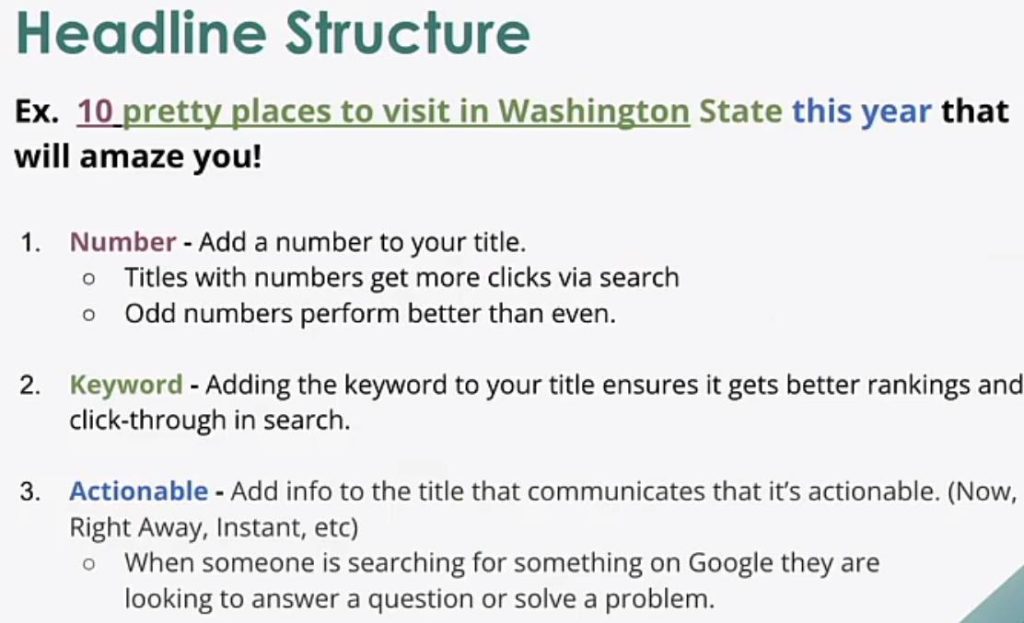
This is an example of the structure that we like to articulate to writers.
You'll notice a pattern between this and Buzzfeed.
Here we've created a headline, we have “10 pretty places to visit in Washington state this year that will amaze you”. If we were to dissect this headline, we can see some characteristics that we like to build into our titles.
First, we have a number. The interesting thing about numbers in the headlines is odd numbers actually perform better than ever.
Don't feel like you necessarily have to have an even although that may feel more natural you could use an odd number which could perform just as well if not better.
Second, of course, adding the keyword in the title not only is that just kind of best practice for SEO these get highlighted in search and so can encourage you to know click through.
Third, make sure that the headline is actionable.
When somebody's searching for something on google we want to be able to answer a question or solve their problem, so make sure that that solution to the discerned query is in the title.
That's gonna make the difference between people clicking through on your result versus the competition.
Content
Now, we want to look at content.
We'll use a lot of different tools for content and some of them at different stages of the process
These are two tools that can work in reference to each other.
They do essentially the same thing but in a different fashion. But I'll talk about them later.
Before that we will do a deep-dive analysis of content, we want to create a quick analysis and this quick analysis allows us to provide an outline to our writers without spending an exorbitant amount of time
Essentially, we want to give them the basic core data that they can write against and then we'll go through an audit later on.
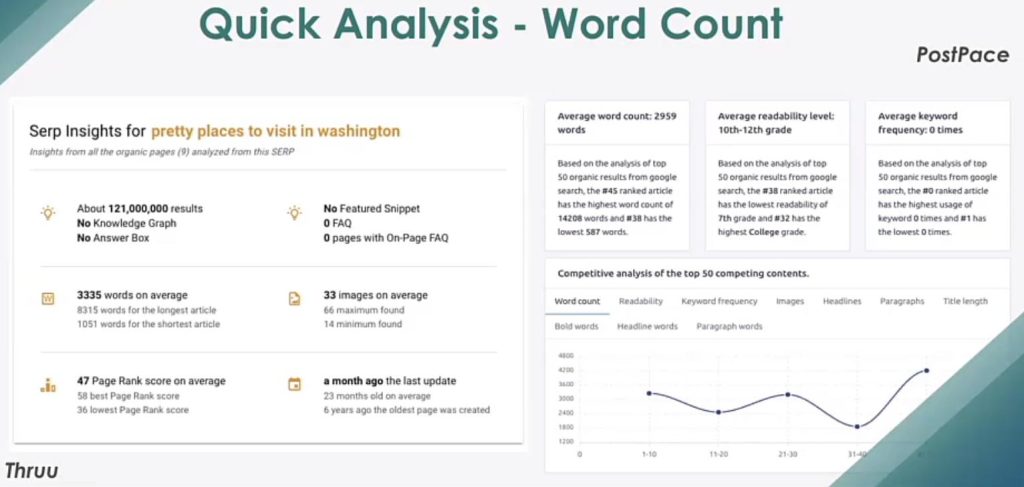
These two tools are really great for that. I think the one that I've been using more frequently is thruu. But again these two tools both postpace and thruu do essentially the same thing.
They're going to go and crawl the SERPs and give you a lot of good data based on that.
Things like your overall word count, the page rank score and that kinds of things can help with writing a piece of content.
First Paragraph
Next, we want to talk about the first paragraph of your content copy.
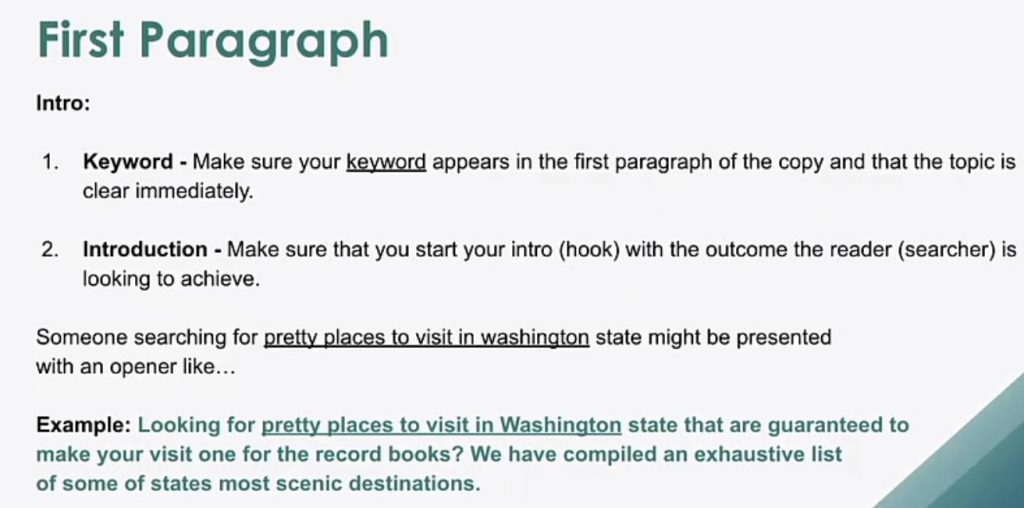
So essentially, you want to layout your first paragraph so that there's a particular structure in place.
First of all, there's your keyword. You want to make sure that your keyword appears in the first paragraph of the copy and that the topic is clear and immediate.
Next, is your introduction. You want to make sure that you start your introduction with a hook, with the outcome that the reader or searcher is looking to achieve.
For instance, someone's searching for the term “pretty places to visit in Washington state” might be presented with an opener like this “looking for pretty places to visit in Washington state that are guaranteed to make your visit one for the record brooks? We have compiled an exhaustive list of some of the state's most scenic destinations.
That's kind of the layout and structure we provide as guidance for that first paragraph because the objective is to get people to read further.
Second Paragraph
Let's talk about the second paragraph.

In the second paragraph, you want to make sure that you outline the benefits that the reader will get from your post.
All of this is intended to get the reader further down the post which builds engagement.
So, in this example, we created a paragraph that says “This post provides you with insider tips and getting the most from your visit to Washington state whether you are looking at some of the state's prettiest destinations or want some advice on romantic weekend getaways our comprehensive guide will uncover some of Washington state's most breathtakingly beautiful destinations”.
We're giving them the benefit before they get into the meat of the content.
Third Paragraph
And then there's the third paragraph.
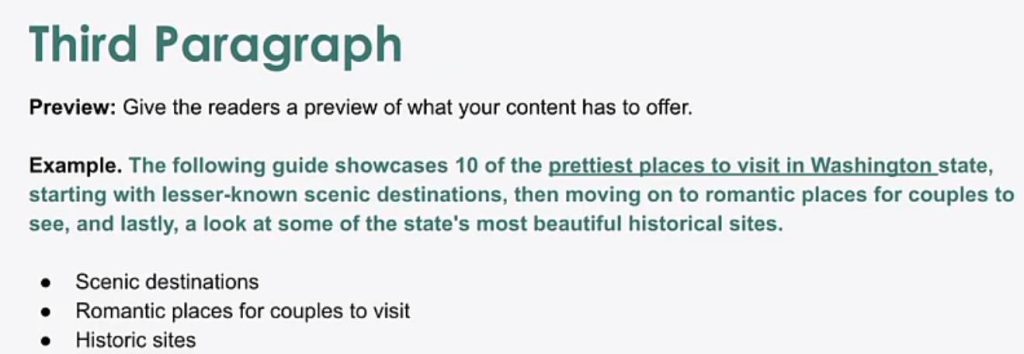
We want to give them a preview of a sample of what is to come.
So in this example, it might say something like “The following guide showcases 10 of the prettiest places to visit in Washington state starting with lesser-known scenic destinations then moving on to romantic places for couples to see and lastly a look at some of the state's most beautiful historical sites.
You may even want to put in your content a bulleted list.
Conclusion
And then there's a conclusion.

You want to use in your conclusion to highlight the main takeaways from the article. This is also the ideal place to include your call to action or promote a related product or service.
So you always want to get the user going to the next step whether it's reading another article, or going into a product or service, that's a good methodology to include in that conclusion.
In the next post we will be talking more on this topic about Page Elements, AI content writing tools, Technical SEO and more. Keep watching this series of posts by subscribing to our newsletter below.
